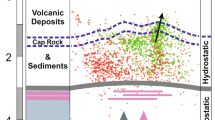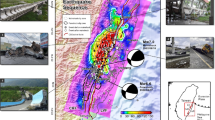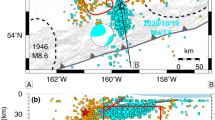Abstract
The great Sumatra–Andaman earthquake and tsunami of 2004 was a dramatic reminder of the importance of understanding the seismic and tsunami hazards of subduction zones1,2,3,4. In March 2005, the Sunda megathrust ruptured again, producing an event5 of moment magnitude (Mw) 8.6 south of the 2004 rupture area, which was the site of a similar event in 1861 (ref. 6). Concern was then focused on the Mentawai area, where large earthquakes had occurred in 1797 (Mw = 8.8) and 1833 (Mw = 9.0)6,7. Two earthquakes, one of Mw = 8.4 and, twelve hours later, one of Mw = 7.9, indeed occurred there on 12 September 2007. Here we show that these earthquakes ruptured only a fraction of the area ruptured in 1833 and consist of distinct asperities within a patch of the megathrust that had remained locked in the interseismic period. This indicates that the same portion of a megathrust can rupture in different patterns depending on whether asperities break as isolated seismic events or cooperate to produce a larger rupture. This variability probably arises from the influence of non-permanent barriers, zones with locally lower pre-stress due to the past earthquakes. The stress state of the portion of the Sunda megathrust that had ruptured in 1833 and 1797 was probably not adequate for the development of a single large rupture in 2007. The moment released in 2007 amounts to only a fraction both of that released in 1833 and of the deficit of moment that had accumulated as a result of interseismic strain since 1833. The potential for a large megathrust event in the Mentawai area thus remains large.
This is a preview of subscription content, access via your institution
Access options
Subscribe to this journal
Receive 51 print issues and online access
$199.00 per year
only $3.90 per issue
Buy this article
- Purchase on Springer Link
- Instant access to full article PDF
Prices may be subject to local taxes which are calculated during checkout



Similar content being viewed by others
References
Lay, T. et al. The great Sumatra-Andaman earthquake of 26 December 2004. Science 308, 1127–1133 (2005)
Chlieh, M. et al. Coseismic slip and afterslip of the great M w 9.15 Sumatra-Andaman earthquake of 2004. Bull. Seismol. Soc. Am. 97, S152–S173 (2007)
Ammon, C. J. et al. Rupture process of the 2004 Sumatra-Andaman earthquake. Science 308, 1133–1139 (2005)
Subarya, C. et al. Plate-boundary deformation associated with the great Sumatra-Andaman earthquake. Nature 440, 46–51 (2006)
Briggs, R. W. et al. Deformation and slip along the Sunda Megathrust in the great 2005 Nias-Simeulue earthquake. Science 311, 1897–1901 (2006)
Newcomb, K. & McCann, W. Seismic history and seismotectonics of the Sunda arc. J. Geophys. Res. 92, 421–439 (1987)
Natawidjaja, D. H. et al. Source parameters of the great Sumatran megathrust earthquakes of 1797 and 1833 inferred from coral microatolls. J. Geophys. Res. 111 10.1029/2005JB004025 (2006)
Ruff, L. & Kanamori, H. Seismic coupling and uncoupling at subduction zones. Tectonophysics 99, 99–117 (1983)
Pacheco, J. F., Sykes, L. R. & Scholz, C. H. Nature of seismic coupling along simple plate boundaries of the subduction type. J. Geophys. Res. 98, 14133–14160 (1993)
Sieh, K., Ward, S. N., Natawidjaja, D. & Suwargadi, B. W. Crustal deformation at the Sumatran subduction zone revealed by coral rings. Geophys. Res. Lett. 26, 3141–3144 (1999)
Burgmann, R. et al. Interseismic coupling and asperity distribution along the Kamchatka subduction zone. J. Geophys. Res. 110 10.1029/2005JB003648 (2005)
Suwa, Y., Miura, S., Hasegawa, A., Sato, T. & Tachibana, K. Interplate coupling beneath NE Japan inferred from three-dimensional displacement field. J. Geophys. Res. 111 10.1029/2004JB003203 (2006)
Freymueller, J. T. & Beavan, J. Absence of strain accumulation in the western Shumagin segment of the Alaska subduction zone. Geophys. Res. Lett. 26, 3233–3236 (1999)
Pritchard, M. E. & Simons, M. An aseismic slip pulse in northern Chile and along-strike variations in seismogenic behavior. J. Geophys. Res. 111 10.1029/2006JB004258 (2006)
Chlieh, M., Avouac, J.-P., Sieh, K., Natawidjaja, D. H. & Galetzka, J. Heterogeneous coupling on the Sumatra megathrust constrained from geodetic and paleogeodetic measurements. J. Geophys. Res. 113 10.1029/2007JB004981 (2008)
Meltzner, A. J. et al. Coseismic, postseismic, and interseismic deformation, and long-term segmentation near the boundary of the 2004 and 2005 Sunda megathrust ruptures. Eos 88 (Fall meeting), abstr. S24A-02 (2007)
Natawidjaja, D. et al. Paleogeodetic records of seismic and aseismic subduction from central Sumatran microatolls, Indonesia. J. Geophys. Res. 109 10.1029/2003JB0002398 (2004)
Natawidjaja, D. H. et al. Interseismic deformation above the Sunda Megathrust recorded in coral microatolls of the Mentawai islands, West Sumatra. J. Geophys. Res. 112 10.1029/2006JB004450 (2007)
Thatcher, W. Order and diversity in the modes of Circum-Pacific earthquake recurrence. J. Geophys. Res. 95, 2609–2623 (1990)
Ando, M. Source mechanisms and tectonic significance of historical earthquakes along Nankai Trough, Japan. Tectonophysics 27, 119–140 (1975)
Lay, T., Kanamori, H. & Ruff, L. The asperity model and the nature of large subduction zone earthquakes. Earthq. Predict. Res. 1, 3–71 (1982)
Rosen, P. A., Henley, S., Peltzer, G. & Simons, M. Updated repeat orbit interferometry package released. Eos 85, 47 (2004)
Rundle, J. B. & Kanamori, H. Application of an inhomogeneous stress (patch) model to complex subduction zone earthquakes - a discrete interaction matrix approach. J. Geophys. Res. 92, 2606–2616 (1987)
Perfettini, H. & Ampuero, J. P. Dynamics of a velocity strengthening fault region: Implications for slow earthquakes and postseismic slip. J. Geophys. Res. 113 10.1029/2007JB005398 (2008)
Liu, Y. & Rice, J. R. Aseismic slip transients emerge spontaneously in three-dimensional rate and state modeling of subduction earthquake sequences. J. Geophys. Res. 110, B08307 (2005)
Ben-Zion, Y. & Rice, J. R. Earthquake failure sequences along a cellular fault zone in a 3-dimensional elastic solid containing asperity and nonasperity regions. J. Geophys. Res. 98, 14109–14131 (1993)
Cochard, A. & Madariaga, R. Complexity of seismicity due to highly rate-dependent friction. J. Geophys. Res. 101, 25321–25336 (1996)
Park, S. C. & Mori, J. Are asperity patterns persistent? Implication from large earthquakes in Papua New Guinea. J. Geophys. Res. 112 10.1029/2006JB004481 (2007)
Ji, C., Wald, D. & Helmberger, D. V. Source description of the 1999 Hector Mine, California earthquake, Part I: Wavelet domain inversion theory and resolution analysis. Bull. Seismol. Soc. Am. 92, 1192–1207 (2002)
Abercrombie, R. E., Antolik, M. & Ekstrom, G. The June 2000 M w 7.9 earthquakes south of Sumatra: Deformation in the India-Australia Plate. J. Geophys. Res. 108 10.1029/2001JB000674 (2003)
Acknowledgements
This study was partly funded by the NSF (grant EAR-0538333) and the Gordon and Betty Moore Foundation. This is Caltech Tectonics Observatory contribution no. 93. We thank R. Burgmann for comments and suggestions.
Author information
Authors and Affiliations
Corresponding author
Supplementary information
Supplementary Information
This file contains Supplementary Notes with Supplementary References, Supplementary Figures S1-S10 and Supplementary Tables S1-S7. (PDF 9803 kb)
Rights and permissions
About this article
Cite this article
Konca, A., Avouac, JP., Sladen, A. et al. Partial rupture of a locked patch of the Sumatra megathrust during the 2007 earthquake sequence. Nature 456, 631–635 (2008). https://doi.org/10.1038/nature07572
Received:
Accepted:
Published:
Issue Date:
DOI: https://doi.org/10.1038/nature07572
This article is cited by
-
East Asian analogues for early Alpine orogenesis
Swiss Journal of Geosciences (2023)
-
Diverse slip behaviour of velocity-weakening fault barriers
Nature Geoscience (2023)
-
Stress accumulation and earthquake activity on the Great Sumatran Fault, Indonesia
Natural Hazards (2023)
-
Oblique plate convergence along arcuate trenches on a spherical Earth. An example from the Western Sunda Arc
Acta Geophysica (2023)
-
On the potential for megathrust earthquakes and tsunamis off the southern coast of West Java and southeast Sumatra, Indonesia
Natural Hazards (2023)
Comments
By submitting a comment you agree to abide by our Terms and Community Guidelines. If you find something abusive or that does not comply with our terms or guidelines please flag it as inappropriate.



